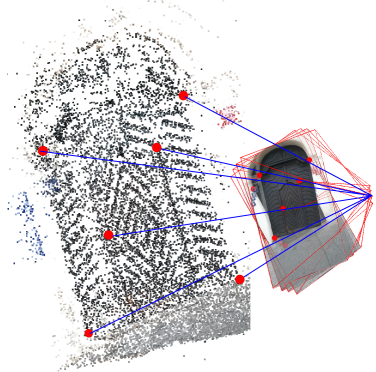Algorithms for computing the rolling shutter absolute camera pose.
More specifically:
- R6P - computes calibrated RS camera pose and velocity from 6 3D<->2D correspondences
- R7Pf - computes RS camera pose and focal length from 7 3D<->2D correspondences
- R7Pfr - computes RS camera pose, focal length and radial distortion from 7 3D<->2D correspondences
For more details please see below.
The algorithms are available in the following languages:
- C++ (all algorithms)
- Python (all algorithms via C++ bindings, R6PIter also in pure Python)
- Matlab (R6P1Lin via MEX, R7Pf and R7Pfr also in pure Matlab)
The provided solvers compute parameters that describe the absolute pose of a RS camera. In addition to perspective camera parameters the solvers also compute the rotational and translational velocity of the camera.
There are two models that are used and returned by the solvers.
Is described by equation
alpha * [x; (1 + rd * ||x||^2); 1] = K * [(I + (r - r_0) * [w]_x) * (I + [v]_x) * X | C_0 + (r - r_0) * t]
Is described by equation
alpha * [x; (1 + rd * ||x||^2); 1] = K * [(I + (r - r_0) * [w]_x) * R_0 * X | C_0 + (r - r_0) * t]
Where
- X : 3D point coordinates (3-vector)
- u : 2D point coorindates (2-vector)
- rd : coefficient of a single parameter radial distortion division model
- C : camera center
- R_0 : camera orientation as a rotation matrix
- v : linearized camera orientation parameters as a 3-vector of a first order Taylor expansion of the camera orientation matrix
- w : camera rotational velocity as a 3-vector of a first order Taylor expansion
- t : camera linear translational velocity
- K : camera calibration matrix as diag(f,f,1)
- r : the row or column coordinate of the 2D projection x, depending which direction the shutter is rolling
- r0 : linearization point of the camera motion
- alpha : perspective depth
- [*]_x is the skew-symmetric matrix of *
- I is an identity matrix
Please see [1] for more detailed description.
Input to the algorithms are either 6 or 7 2D<->3D corredpondences, depending on the algorithm. The output are N solutions for the camera parameters.
C++ example: int num_corresp = 6; Eigen::MatrixXd X = Eigen::MatrixXd::Random(3,num_corresp); Eigen::MatrixXd u = Eigen::MatrixXd::Random(2,num_corresp);
The library can be compiled with CMake. This will produce the static C++ library, if you want Python or MATLAB bindings see below. The Python bindings are produced thanks to the amazing library Pybind which is included as a submodule.
Follow the classic procedure:
git clone https://github.com/CenekAlbl/RnP.git
cd RnP
git submodule update --init --recursive
mkdir build
cd build
cmake ..
make
Since the compilation with optimizations can take very long, we recommend trying DEBUG version first:
cmake .. -DCMAKE_BUILD_TYPE=DEBUG
After a successful compilation, we recommend to run the tests:
make test
You can also run the benchmark to see the runtime of each algorithm on your machine:
./benchmark
Naturally, you should do it after compilation in the default RELEASE mode, not DEBUG.
If you want to compile the Python bindings then:
cmake .. -DPYTHON_BINDINGS=1
make pyrnp
If you want to compile with MATLAB bindings then:
cmake .. -DMATLAB_BINDINGS=1
It tries to find Matlab and Python automatically. If it fails to find yours or you want to specify a different version to be used, try:
-DMatlab_ROOT_DIR=/path/to/your/matlab/folder
or:
-DPython_EXECUTABLE=/path/to/your/python/binary
For an example how to use the algorithms take a look in the folder tests or in c++/benchmark.cpp.
This is the 7 point version for cameras with unknown intrinsics. There are 2 algorithms:
- R7Pf - computes the camera pose + velocity + the focal length
- R7Pfr - computes the camera pose + velocity + the focal length and radial distortion
The algorithms were presented in:
[1] Z. Kukelova, C. Albl, A. Sugimoto, K. Schindler, T. Pajdla, "Minimal Rolling Shutter Absolute Pose with Unknown Focal Length and Radial", European Conference on Computer Vision (ECCV) 2020
This is the single-linearized standalone RS absolute pose solver presented in:
[2] C. Albl, Z. Kukelova, V. Larsson and T. Pajdla, "Rolling Shutter Camera Absolute Pose," in IEEE Transactions on Pattern Analysis and Machine Intelligence, 2019.
This is the double-linearized RS absolute pose solver that needs an initial camera orientation estimate also presented in:
[3] C. Albl, Z. Kukelova, V. Larsson and T. Pajdla, "Rolling Shutter Camera Absolute Pose," in IEEE Transactions on Pattern Analysis and Machine Intelligence, 2019.
which solves the same equations, but faster than the original:
[4] C. Albl, Z. Kukelova and T. Pajdla, "R6P - Rolling shutter absolute pose problem," 2015 IEEE Conference on Computer Vision and Pattern Recognition (CVPR), 2015.
This is the iterative version of R6P-2lin that needs an initial camera orientation estimate and was presented in:
[5] Kukelova Z., Albl C., Sugimoto A., Pajdla T. Linear Solution to the Minimal Absolute Pose Rolling Shutter Problem. Asian Conference on Computer Vision, 2018.
